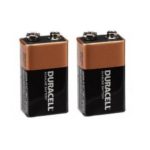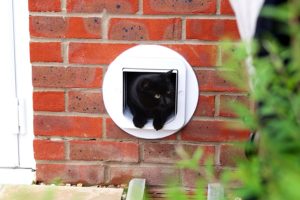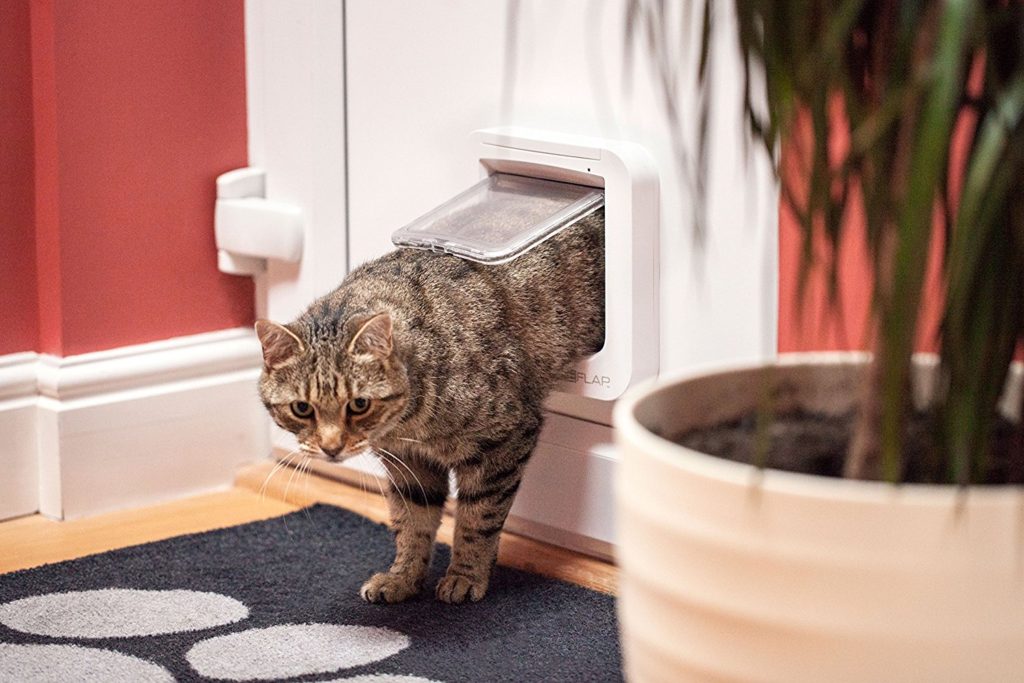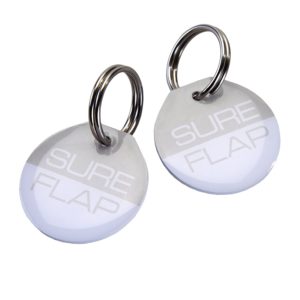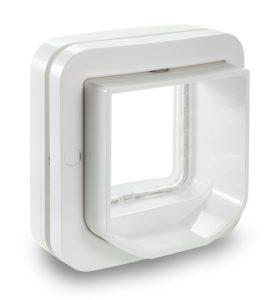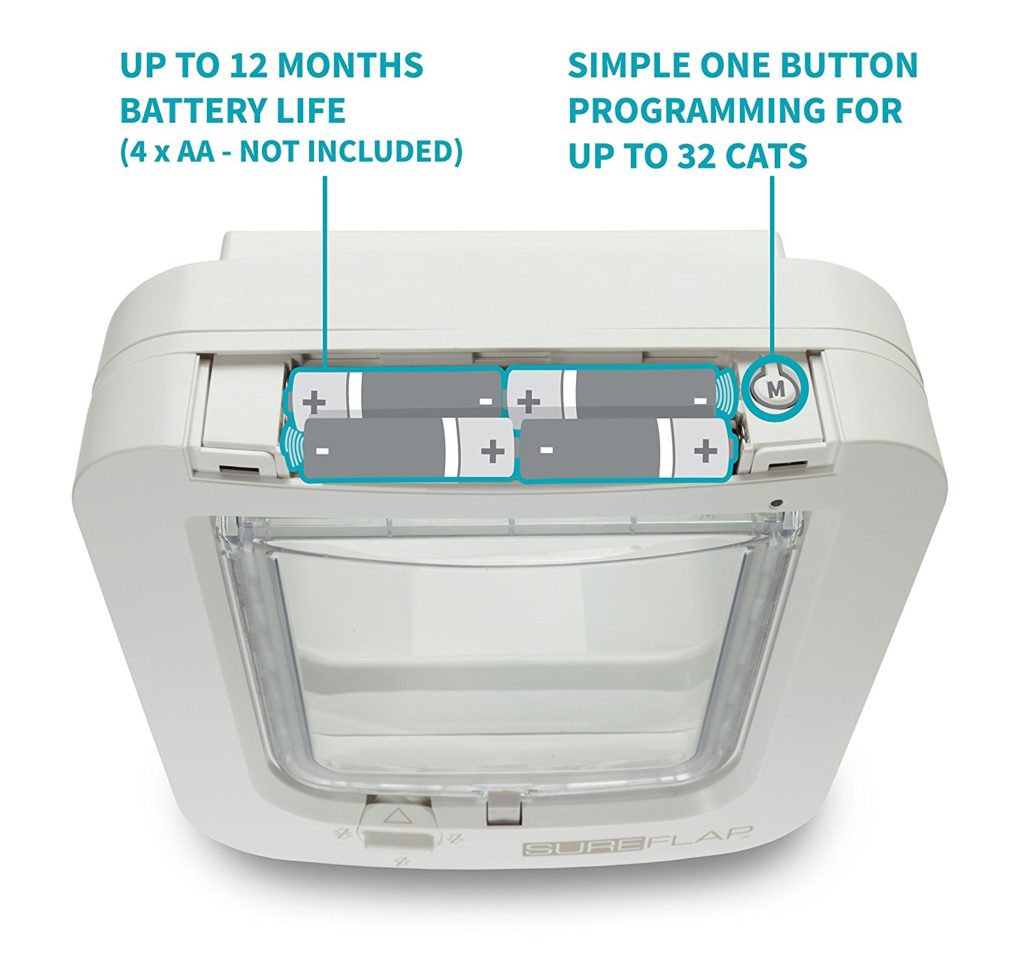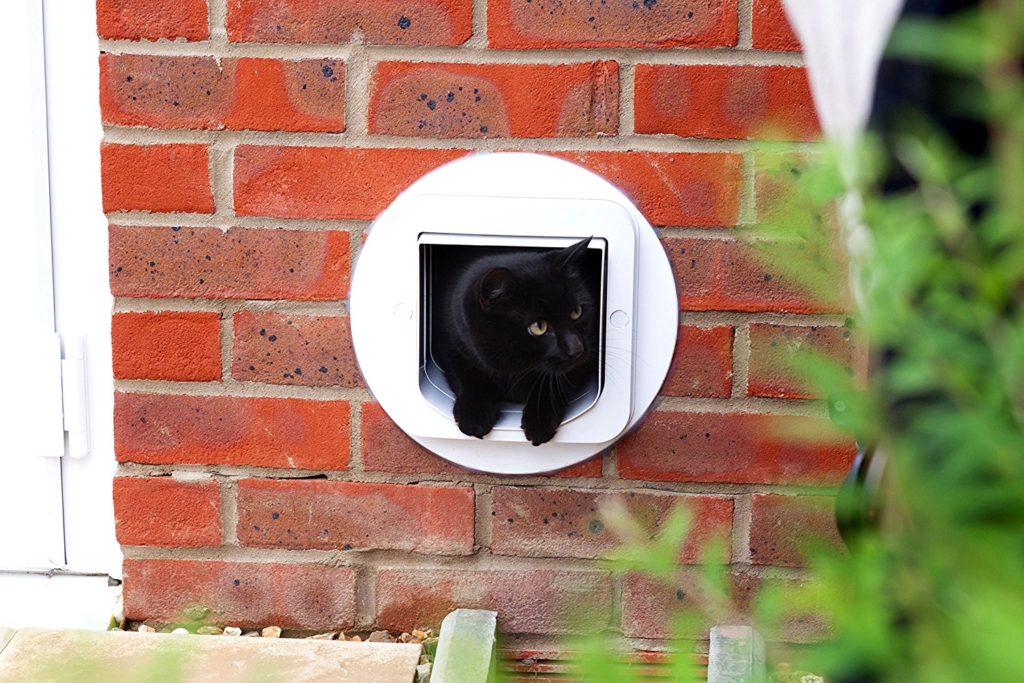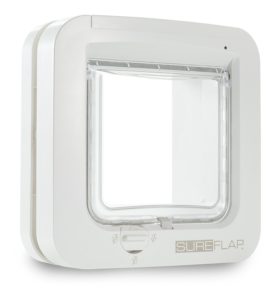Automatic cat doors are a awesome way of keeping unwanted animals out, and your dear kitties or other pets inside your house. Or outside. Electronic cat doors are programmable in pretty much any setting you might want. In this column, we shall take a deeper look at the Cat Mate Electromagnetic Cat Flap
.
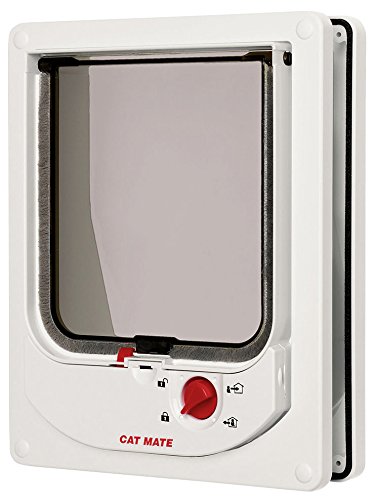
What is the Cat Mate Electromagnetic Cat Flap?
The Cat Mate Electromagnetic Flap is an automatic cat door that provides your pet the choice to exit and type in the home as many times he/she wants, enjoying your backyard and relieving you from full-time doorman duty.
The Cat Mate electronic pet door gives a safe way of letting your cats roam free because it identifies your cat through sophisticated electromagnetic technology. It also enables your cats to get into your dwelling without allowing stray cats, raccoons or other animals to enter your house.
The door recognizes your cat by utilizing a small magnet. The magnet also works as an identification tag, attached to your pet’s collar.
A sensitive circuit centrally located on the control board, senses if the magnet tag is near and if it is, it allows your pet to get through the flap.
This device has 4-way locking settings:
- Both ways
- Go inside only
- Go outside only
- Locked.
Frame lining to two 3/8 (60mm). Makes it ideal for all doors. The control panel uses one 9-volt battery, which is not included.
The Cat Mate Electromagnetic cat door comes with two small magnets that can be attached to your cat’s collar, much like a title tag.
What Are the Features of This Device?
- Electromagnetic cat door with 4 types of locking options
- Includes two small magnets for your pets to wear.
- It opens only to the pet that is equipped with the magnet.
- Keeps all other unwanted animals out.
- Flap with brush: weather-proof seal, reducing warmth loss, draft coming in, and makes for quieter flapping.
- Detailed instruction manual included
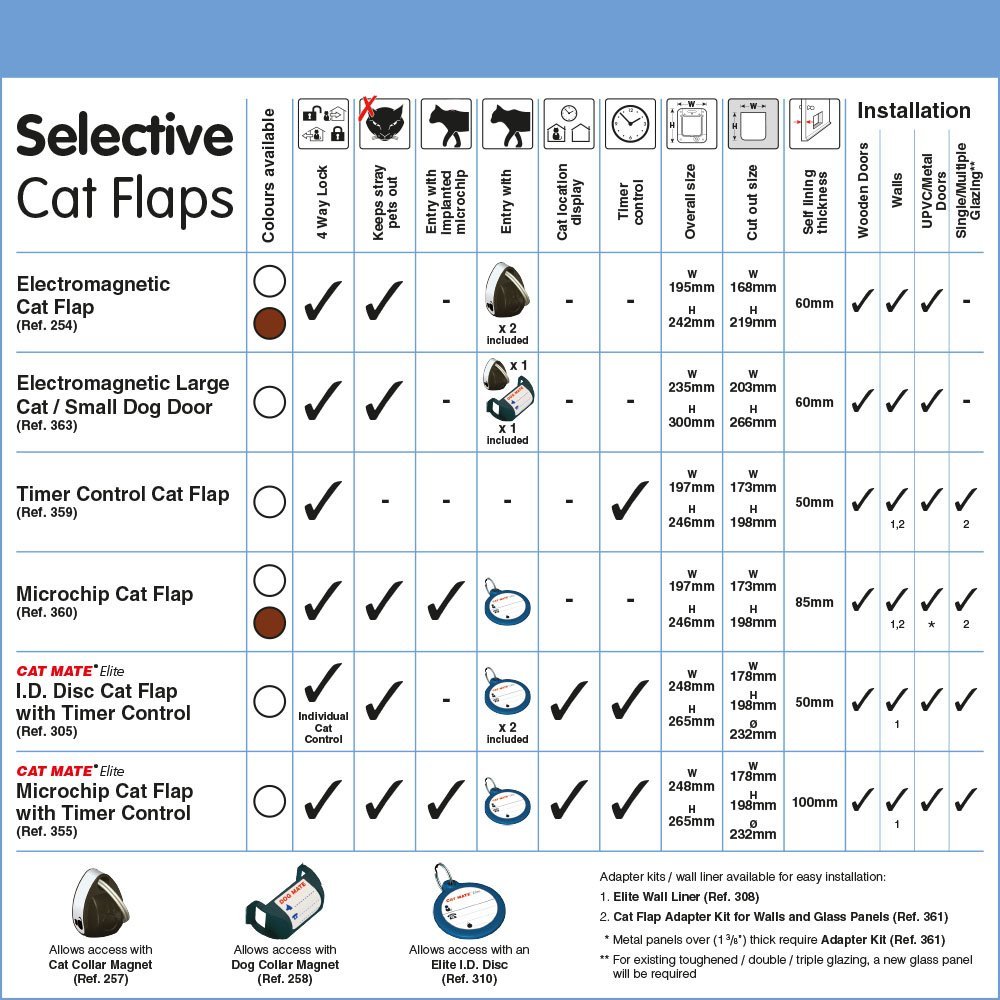
What are the Dimensions and Technical Requirements?
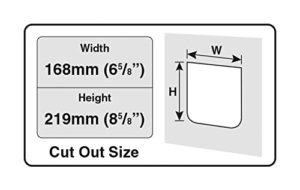 Overall Door Size:
Overall Door Size:
9-1/2-inch tall, 7-5/8- inch wide
Size of the Hole Needed To Fit This Door:
8-5/8-inch tall x 6-5/8-inch wide
 Size of the Cat Entrance:
Size of the Cat Entrance:
6-1/2-inch tall x 6-inch wide
Yes. one PP3 9v. alkaline battery. Batteries last approx. twelve months.
Suitable for:
Doors and panels
How Does This Device Work?
The Cat Mate cat door detects the area of a great compact magnet the cat uses in its collar and unlocks a latch that enables the cat to get into the home from the outside by pressing the door with its nose or perhaps head to get in. After the cat gets inside, the door returns to its usual place to get locked.
The locking system prevents the door from swinging into the home, but not from swinging outwards.
How the 4-Way setting works:
- Two-way
The cat using the magnet on its collar can exit and type in the cat door. The cat just needs to use the magnet when entering the door but not when getting out. - Entry only
Useful setting in case you would like to keep your cat inside at night. The locking has to be done manually when your cat is inside. - Exit only
This feature enables you to keep your cat outside. - Locked
The pet door is fully locked.
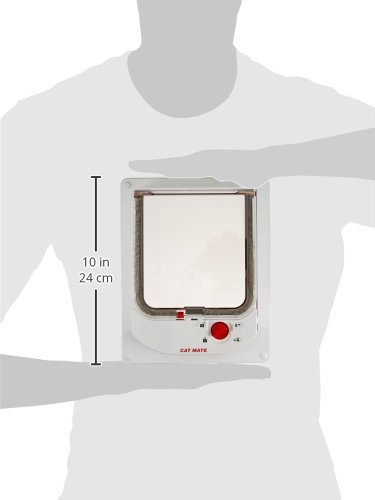
Is This Cat Door Easy To Install? Can You DIY or Should You Hire Someone?
The Electromagnetic Cat Mate door is pretty simple to set up. You’ll need a jigsaw, a drill, and a screwdriver. In the item description, you read about the lining. A liner is a frame that is set up through the door, to cover up the interior of the door.
Self-lining ways that you do not have to construct the frame for the cat flap if used in door or perhaps panels.
How to install the Cat Mate Electromagnetic in plastic panels and wooden doors.
These directions are for basic guidance only. You’ll see a far more detailed information and more tips on various types of installations in the instruction booklet.
- Place the template in the position you would like the cat door. The bottom part of the gap has to be the same height than your cat’s lower stomach.
- Draw the cat flap’s hole around completely.
- Before cutting the hole, drill two holes of approximately 1/4 (6mm) diameter in both of the most suited corners.
- Cut the hole along the interior of the drawn line using an (electric) jig-saw.
- Determine the thickness of the panel in your door, and use the right screws.
- Screw it tight, attaching both parts of the cat door.
Advantages and Disadvantages The Cat Mate Electromagnetic Cat Flap?
The Good
- 4-Way locking system.
- Simple directions and easy installation.
- Large size, it allows cats up to thirteen lbs to pass though.
- The collar magnets are generic magnets. You have a wide selection of buying options to get yourself some back up collars. The magnets just have to be strong enough.
- Feral and neighborhoods cats can not use the cat door, provided they don’t have a magnet on their collars.
- Flap with brush weather-proof seal.
- Low-noise: Not a loud sound when unlocking the flap.
- Battery lasts longest compared to all other automatic cat doors.
- Recommended for keeping indoor spaces separate.
- Wallet-friendly. Good price point.
The Bad
- Any cat with a magnet can use the cat door; magnets can’t be programmed to specific pets.
- The locking mechanism cannot be offset automatically. You have to tape the latch down to train your cat in the beginning.
- The cat door only locks when swinging in, but not when rocking outwards.
- An intelligent cat or raccoon can certainly pull the flap open and enter through the door. This occurs only rarely, with extraordinarily intelligent cats and like-minded raccoons.
- The magnet on the collar can attract other metal objects. The magnets might limit your cat. No more bells in cat toys, or metal tag names.
- It usually requires the magnet to be at a particular level to do the job (margin of error is approximately 0.39″ or one cm), but this may be modified with the placement on the cat’s collar.
- The cat flap makes a clicking noise when it unlocks. It’s not obnoxious, but it might affect scaredy cats.
- The door sometimes fails to lock when swinging back into the original position. The majority of the time, it does lock, but not 100 % of the time. Faulty locking can be due to the wind or a tail trapped in the door, etc.
- The lining is not ideal for thick, sturdy walls
- The brush strip on the flap gets dirty with cat hair. You need to clean it occasionally.
Device Usage Tips From Other Customers

Before you buy it, think about the size of your cats. Make sure they will fit through the cat door effortlessly.
When putting the magnet in your cat collar, make sure the paw print of the magnet is facing forward. Additionally, be sure to connect the magnet band around the collar rather than only clipping it to the current metal band on the cat collar. It will prevent the magnet from going sideways
In the beginning, it might be a good idea to tape the door wide open, and place the magnet on your cat’s collar. This way you can get your kitty used to the clicking noise, without any locking mechanism in place. Your cat can take it’s time without feeling rushed.
To keep from having excess cat hair in the brush strip, clean the door from time to time.
If the cat door opens in a half-open position, check out the holes on top sides of the cat door. It probably means they have not been drilled deep enough. thus stopping the hinge from moving freely.
Our Conclusion
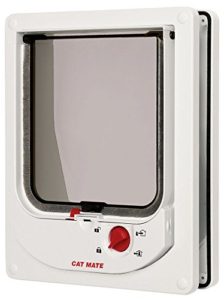
The Cat Mate Electromagnetic cat door works to prevent stray animals from entering the home, and it’s suitable to be used inside too.
However, the flap may be pulled outwards. That might be a flaw with really brazen wild animals and raccoons.
In the event that you have to have a little-added protection against neighborhood pets or even to other animals inside your home, this is a great alternative for you.
If unwanted animals or perhaps other animals outside are remarkably intelligent, powerful and stubborn, this may not work for you.
The Cat Mate Electromagnetic pet door is the very best of this particular kind in this price range, despite the less favorable facts that the points above mentioned.
If you would like a reliable, limited entry system that is 100 % animal-proof, perhaps it’d be a better strategy to get a higher-tech product that has a locking setting in both sides of the flap.
As a result of each of the advantages and disadvantages, and the points mentioned,
we suggest the Cat Mate Electromagnetic cat door:
- To households with small to above-average sized cats.
- People who live in areas where there are no other (stray) animals attempting to get in through the pet door
- To keep your neighbor’s cat or not so intelligent raccoons out.
- To separate pets inside your home, if you want to create separate feeding stations or litter box placements
This device might not be ideal for:
- Cats that weight over thirteen lbs
- Scaredy cats or cats scared of noise
- To stop extra aggressive or intelligent pets or raccoons.

